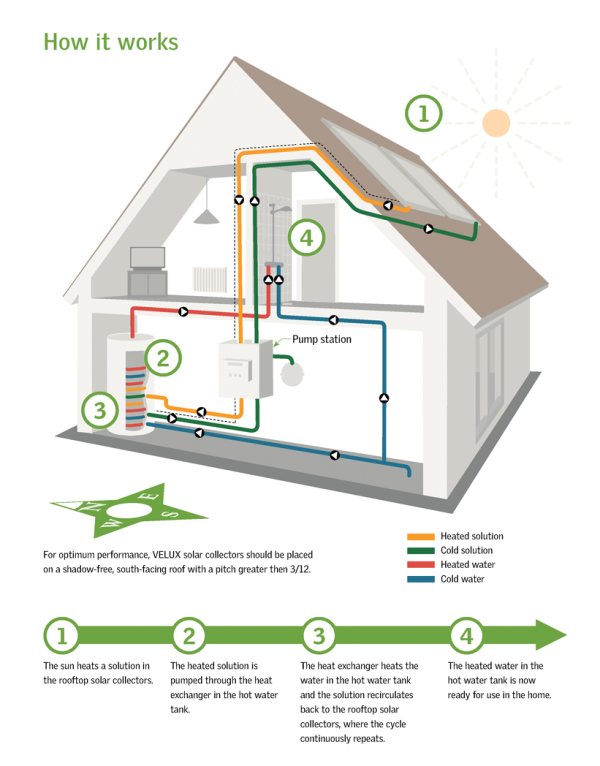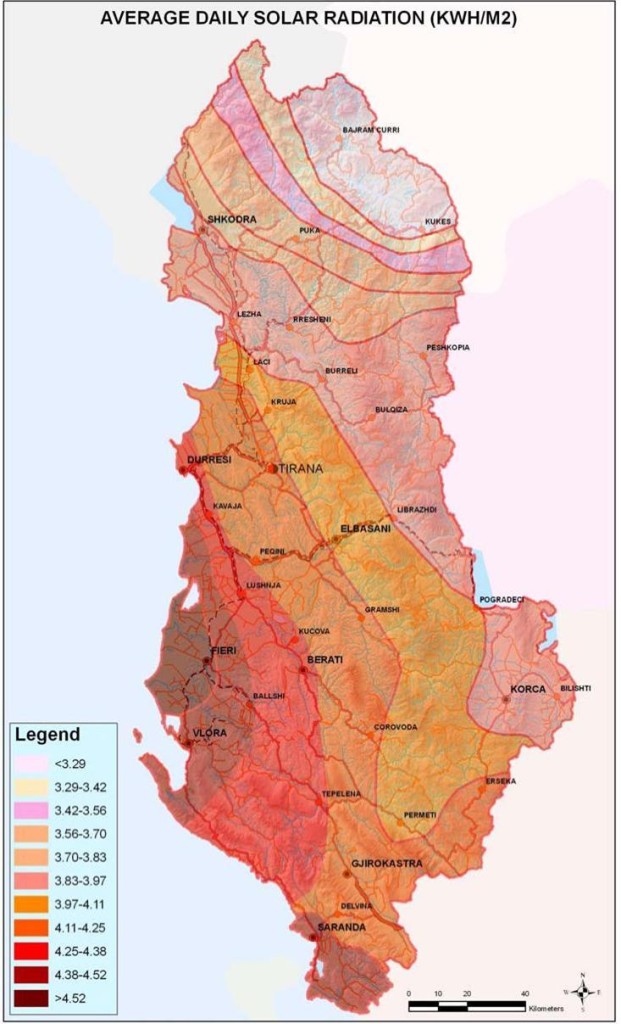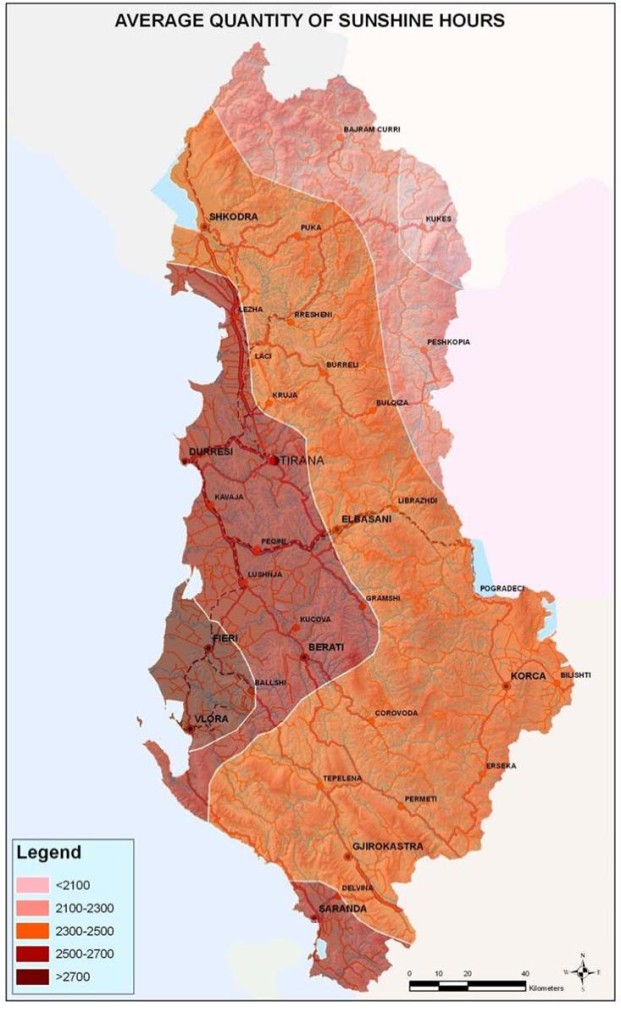Albania Solar energy
With solar energy, we distinguish usually two conversion types: solar thermal, solar PV (or photovoltaic solar energy)
In this study we are focusing more on solar thermal energy. Solar thermal energy is the process where solar radiation is converted into thermal energy. The most common system is the solar water heater system (SWHS). The water is heating by the sun through a collector, usually placed on the roof of the building. The warm water is stored in a tank or directly used to heat the house or preheat another boiler.
Sometimes a distinction is made between active systems (such as a SWHS) and passive systems. An example for a passive system is a greenhouse that captures solar radiation without any additional process.
Background
The Preskot model is used for the assessment of the territorial distribution of solar radiation. The model has been adapted to the climate conditions of Albania, taking into consideration the multi-annual series of solar radiation (Mustaqi and Sanxhaku 2006). The following factors are considered as crucial in the assessment of solar radiation:
- The geographic location of the country, which defines the possible theoretic potentials of the solar energy, taken from the horizontal surface of the earth.
- Topography (closely connected to the scale of horizon hided from natural barriers), which defines the practical possible potential of the solar energy taken from the earth horizontal surface.
- Baric systems (their occasionally and time duration), which define the characteristics of the cloudiness regime
It is very clear that the last two factors have the major impact in the identification of the solar energy characteristics. The influence of both factors is at the same direction, the decrease of solar radiation towards the inner part of the territory. Concretely, the heliographic measure spots (at the same time the inhabited areas) are located at the end of the valleys of the rivers. As a result the horizon is relatively closed to the mountainous slopes. It is evident that the solar radiation quantity measured in the station is smaller that the one taken on earth surface located in a plateau or locations of a relative height. On the other side, analyzing the cloudiness regime in the territory, it results that, an average of 5 degrees in the field areas and of 6-7 degrees in the mountainous areas. Consequently, the reduction of the solar radiation can also be noticed.
The reducing effect of topography factor can be avoided by recommending areas as plateaus in considerable heights, with an open horizon. Meanwhile, it is important to point out that the effect of causality and the duration of baric systems can not be avoided because of the stochastic character of the atmospheric phenomena. The result of these factors is the distribution in the territory of the annual solar radiation, as presented in the following maps (figure 15 and 16).
Potential
As it can be seen from this map, Albania has a considerable energy coming through the solar radiation. This quantity varies from 1200 kWh/m2 in the northeast part of the country (the area than receives the lowest quantity of the solar radiation) up to 1600 kWh/m2 in Myzeqe area, which is the area that has a considerable quantity of this energy kind (Hido 2006). The average of daily solar radiation can change from a minimum of 3.2 kWh/m2 in the Northeast (day in Kukes) up to a maximum of 4.6 kWh/m2 in the South-Western (day in Fier). Therefore, Albania has an average of daily solar radiation of 4.1 kWh/m2, which can be considered as a good solar energy regime.
Most areas of Albania benefit more than 2200 hours of sunshine per year, while the average for the whole country is about 2400 hours. The Western part receives more than 2500 hours of sunshine per year. Fier has a record of 2850 hours. The number of the solar days in Albania has an average of 240 – 260 days annually with a maximum of 280 – 300 days annually in the South-Western part. The potential of solar thermal is not merely determined by irradiation characteristics (which positively considered in Albania) but also by availability of roof space and orientation and inclination of the roof, the collector and storage as well (Ecofys BV2006). More detail for some cities you will find on Annex B.
Installed capacity
The penetration of solar panel systems are used for thermal power production during the last decade increased from 0 to 23 GWh in 2001. Nevertheless, based on the surveys of National Agency of Energy (NAE), the number of the installed solar panels in 2003 is increased with 35% compared to 2002. In absolute values, the number of solar panels installed in 2003 was 2800 units, while in 2005 it is expected to go beyond 4000 units (MIE and NAE 2004).
Energy Efficiency Centre (EEC) has designed and implemented in kindergartens and schools three projects funded by EU in 2002-2003. The investment amount has been around 85000 EUR installing more than 200 m2 of solar panels. Based on the assistance of UNDP during 2003, an amount of 160 m2 of solar panels has been installed. The total of the investment reached 70000 USD (EEC 2002).
Nehemia Foundation, has installed 168 m2 solar panels and a contemporary heating systems in three schools of Pogradec with a beneficiary number of 650 students. In the framework of this project 28 m2 photovoltaic systems have been installed aiming to supply the computers and lightening system when power cuts.
Another significant project in the area of solar panels is currently under implementation. Global Environment Facility (GEF) through UNDP is supporting the Government of Albania to accelerate the market development of SWHS as one of the measures to reduce the growing electricity consumption and disparity between demand and the domestic power generation capacity. This country program aims at accelerating the market development of solar water heating. It is expected that the end of the projects meets the following: the installation of 75,000 m2 of new installed collector area, an annual sale of 20,000 m2 and with expected continuing
growth to reach the set target of 540,000 m2 of total installed SWH capacity by 2020 (UNDP 2005). The project is financed partly by GEF through UNDP, and Government of Albania as well as from other donors and private sector.
If Albania would develop the solar panels at similar level of Greece, the potential production of warm water would be equivalent to the energy production of 360 GWh thermo (or 75 MW thermo of the installed power). These amounts correspond to a total surface of 300,000 m2 (or 0.3 m2/family. The penetration in such countries as Israel, Greece, Turkey is actually over 0.45 m2/familje), which can be taken as a potential indicator for Albania for the coming 20 years.
Characteristic features for Albania
The position of Albania, which has a Mediterranean climate, generates favourable conditions for a sustainable development of the solar energy. The high intensity of solar radiation, its relatively long duration, the temperature and the air moisture are exactly the elements that contribute to this effect. The Mediterranean climate with a soft and wet winter and a hot and dry summer enables Albania to have higher potentials in solar energy use than the average of the European countries.




